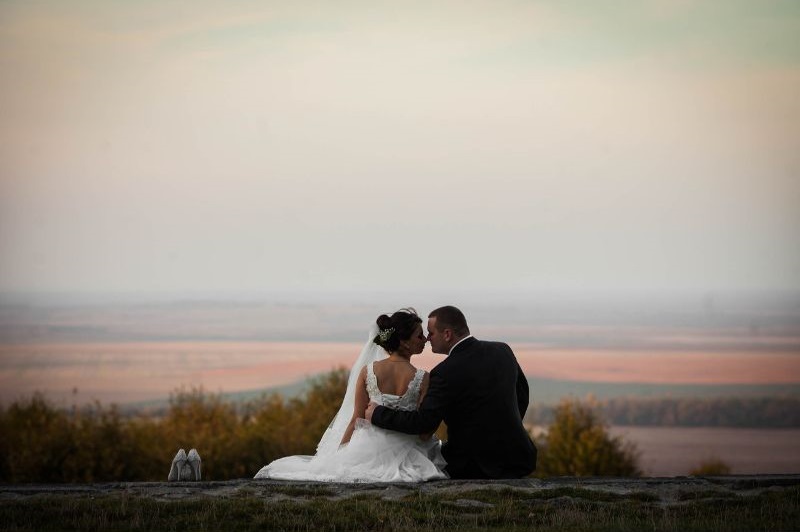Picture this: you and your partner bathed in warm, ethereal light that makes your skin glow like it’s been kissed by the sun itself.
This isn’t some heavily edited fantasy—it’s the magic of golden hour, and it’s the secret weapon every experienced photographer swears by for creating stunning wedding images. But here’s the question couples always ask: what time is golden hour for weddings, and how can you actually plan your day around it?
The answer isn’t as simple as checking your watch. Golden hour shifts with the seasons, your exact location, and even the weather conditions on your wedding day. Understanding this magical window of light can make all the difference between good wedding photos and absolutely breathtaking ones that take your breath away every time you look at your album.
Understanding Golden Hour and Why It Matters for Wedding Photography
Golden hour is that magical window when natural light transforms ordinary photos into extraordinary art. Let’s break down exactly what it is and why it matters for your wedding day.
What Is Golden Hour?
Golden hour refers to the period shortly after sunrise or before sunset when the sun sits low on the horizon, creating that coveted warm, diffused light that photographers dream about. This natural light phenomenon happens twice daily, though most couples focus on the evening golden hour since it typically aligns better with their photography timeline.
Why Golden Hour Creates the Most Flattering Light
The low angle of the sun during this time produces several key benefits:
- Eliminates harsh shadows: No more unflattering dark shadows that plague midday photography
- Creates natural dimension: Light wraps around subjects naturally without complex setups
- Enhances skin tones: Makes everyone look naturally radiant and glowing
- Adds romantic lens flare: Beautiful sun streaks that add emotion to couple portraits
- Perfect background quality: The scenery takes on an almost dreamlike quality
For wedding photography specifically, this means your dress details catch the light beautifully, and you’ll capture intimate portraits that look effortlessly stunning. Unlike early afternoon sun, golden hour provides the perfect light for those unforgettable moments between you and your partner.
Calculating the Exact Time of Golden Hour for Your Wedding Date
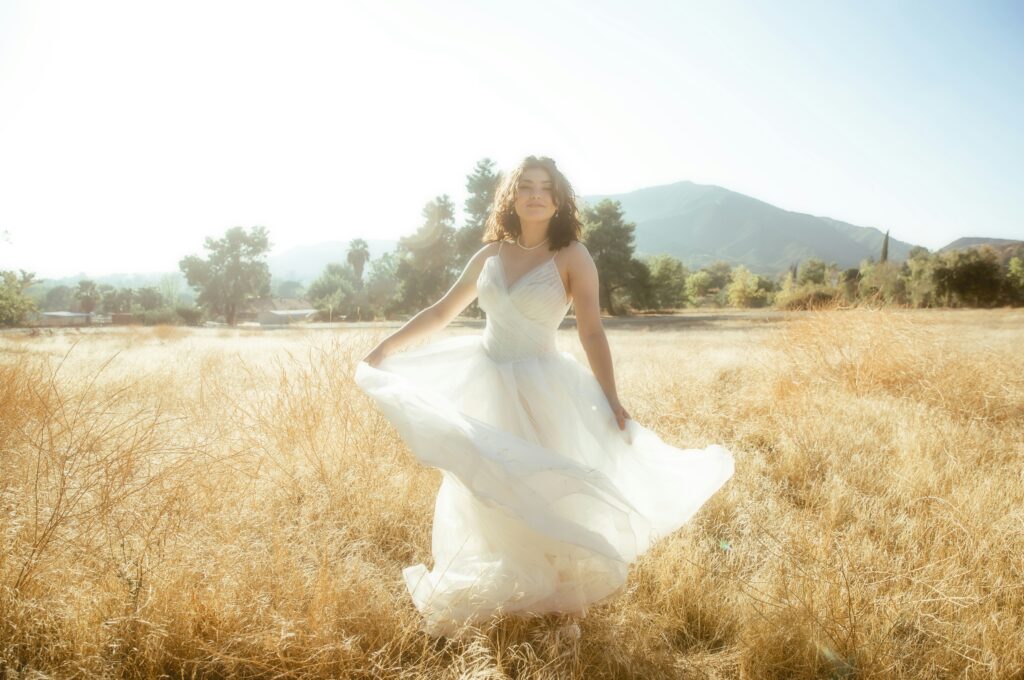
The timing of golden hour isn’t one-size-fits-all—it shifts based on your location, season, and wedding date. Here’s how to calculate the perfect timing for your big day.
Seasonal Timing Guide
Summer months bring golden hour between 7:00 and 8:30 PM in most locations, while winter weddings may catch this magical light as early as 4:00 and 5:30 PM. Spring and fall typically fall somewhere in between at 6:00-7:30 PM. The general rule is that golden hour starts approximately one hour before sunset and lasts until the sun sets completely, though this varies based on your venue’s surroundings and cloud cover.
Finding Your Exact Golden Hour Time
To calculate the precise golden hour for your wedding date and specific location, visit resources like The Photographer’s Ephemeris. Input your exact location and wedding date to see exactly when the sun will provide that perfect light. Your wedding photographer should be familiar with these tools and can help you plan your photography timeline accordingly.
How Golden Hour Transforms Your Wedding Images
The difference between standard daylight and golden hour photography isn’t subtle—it’s transformative. Here’s exactly what makes these photos so special.
The Warm, Romantic Glow
Golden light adds natural warmth to skin tones that’s nearly impossible to replicate in post-processing. Your wedding images will have an inherent glow that makes everyone look their absolute best—no heavy editing required. This warm, romantic atmosphere becomes the foundation of images that feel timeless and emotional.
Beautiful Depth and Dimension
The directional quality of light creates longer shadows that add depth to your photos. Unlike flat overcast lighting or harsh midday sun, golden hour strikes the perfect balance—strong enough to illuminate beautifully, soft enough to be universally flattering. This natural dimension makes your subjects pop against their backgrounds in a way that feels three-dimensional and alive.
Stunning Sky Backgrounds
The sky transforms into a canvas of colors during golden hour. As the sun sets and you transition into blue hour, the sky becomes a stunning backdrop ranging from pink and orange to deep blue and purple. These natural gradients create magazine-worthy backgrounds without any artificial intervention, turning simple portraits into works of art.
Planning Your Wedding Photography Timeline Around Golden Hour
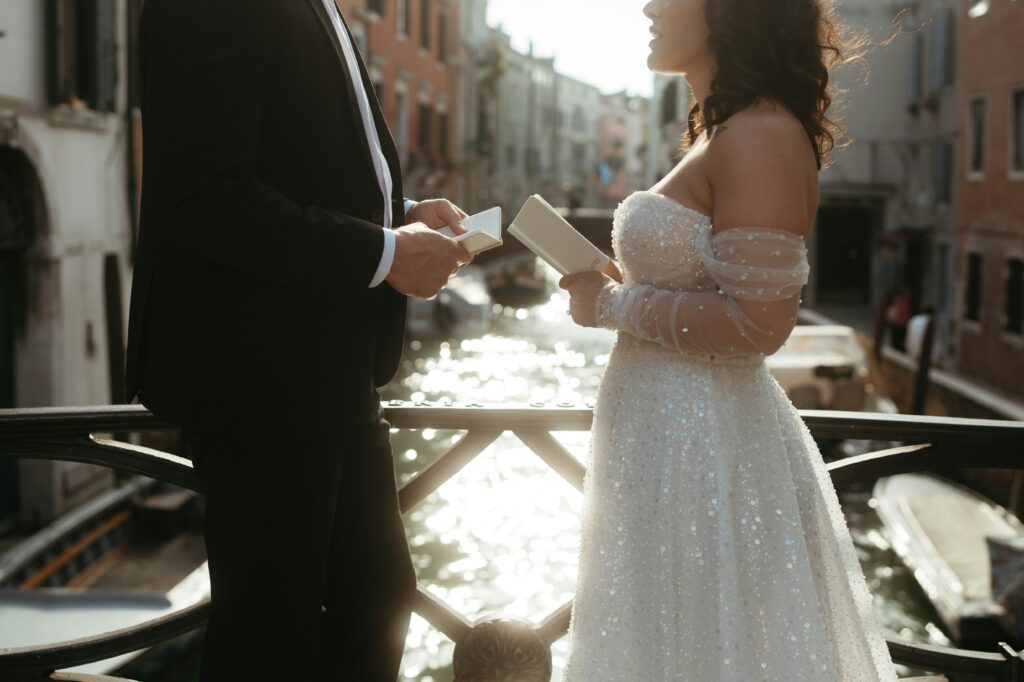
You don’t need to rearrange your entire wedding day to capture golden hour magic. Strategic planning makes it possible to enjoy your celebration while still getting those stunning sunset portraits.
Option 1: Evening Ceremony Timing
Schedule your outdoor ceremony to conclude as golden hour begins. This allows you to capture both your ceremony and immediate post-ceremony couple portraits in beautiful light. Your cocktail hour flows naturally while you and your partner steal away for 20-30 minutes of golden hour photography.
Option 2: First Look Strategy
Consider doing a first look earlier in the day. Complete family photos and wedding party shots when the sun isn’t ideal, then save golden hour exclusively for intimate portraits of just the two of you. Learn more about creating an efficient timeline that accommodates all your photo priorities.
Option 3: Sunset Portrait Session
Schedule a dedicated 30-minute portrait session during golden hour, even if it means stepping away from cocktail hour or dinner briefly. Communicate this plan with your wedding planner and photographer so guests understand you’ll be capturing special sunset shots.
Essential Timing Considerations
- Allow at least 30-45 minutes for golden hour portraits
- Build in a 10-15 minute buffer for unexpected delays
- Consider travel time between the ceremony and the photo location
- Plan ahead for sunset times that might conflict with the first dance or dinner
- Coordinate with your wedding planner to keep the timeline flowing smoothly
Working with Different Lighting Conditions Throughout Your Wedding Day
While golden hour provides the best light for portraits, a skilled photographer creates beautiful photos all day long. Understanding different lighting scenarios helps you appreciate why golden hour is special—and what alternatives exist.
Early afternoon sun creates harsh shadows and bright, contrasty light that’s challenging for portraits. However, this lighting works wonderfully for detail shots of your rings, dress, and venue decor. Your photographer will seek shaded areas or use reflectors to manage this light for any necessary portraits during this time.
Overcast days actually provide consistently diffused light similar to a giant softbox—photographers often love cloudy skies for this reason. While you won’t get the warm golden tones, you will get even, flattering light that eliminates harsh shadows and creates soft, romantic images throughout your day.
Blue hour follows immediately after golden hour and offers its own unique aesthetic. As the sun sets and the sky deepens into rich blues and purples, you can capture dramatic, moody portraits that feel artistic and editorial. This is particularly striking for nighttime venue shots and dance floor photography with ambient lighting creating intimate atmospheres.
Choosing the Right Location for Golden Hour Photos
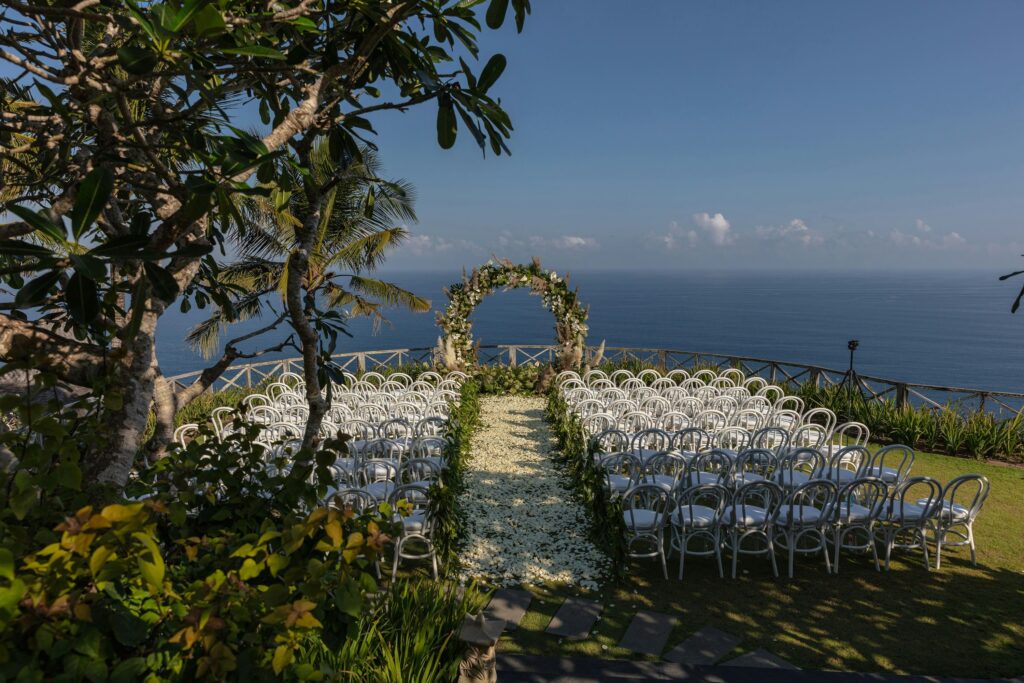
Not all locations are created equal for golden hour photography. The perfect spot requires several key elements to maximize that beautiful light.
Your venue needs a clear view of the horizon where the sun sets. Buildings, trees, or hills blocking the setting sun will cut your session short and limit light quality. When touring potential venues, ask about sunset visibility and whether there are dedicated areas for late afternoon photography.
Consider the background and scenery carefully. Golden hour light looks spectacular, but cluttered backgrounds ruin the overall image. Look for locations with clean sight lines—open fields, waterfront views, architectural elements, or natural landscapes that complement rather than compete with your subjects.
Accessibility matters tremendously. If your golden hour location requires a 15-minute walk from your reception venue, you’ll eat into precious photography time. Choose a spot that’s close enough to reach quickly (5 minutes or less) but far enough to provide privacy and beautiful scenery. Planning your golden hour photos requires this kind of strategic thinking about location logistics.
What to Communicate with Your Wedding Photographer
Your photographer is your partner in capturing golden hour magic, but they need specific information from you to make it happen seamlessly. Clear communication ensures everyone’s on the same page.
Share your vision for these photos early in the planning process. Do you want romantic, close-up couple portraits? Wide landscape shots showing scenery? Candid, lifestyle-style images with movement? Understanding your preferences helps your photographer plan the shot list and choose the best location accordingly.
Discuss backup plans for weather scenarios as well. While golden hour happens regardless of cloud cover, heavy rain or storms might force you indoors. A skilled, experienced photographer will have contingency plans for creating beautiful images in any condition. Knowing what to do if it rains ensures you’re prepared for anything.
Be realistic about your timeline flexibility. If you’re not willing to step away during cocktail hour or dinner, be upfront about that. Your photographer can then adjust expectations and capture the best available light at other times during your day. Understanding what to expect from your photography coverage helps align everyone’s priorities.
Preparing for Your Golden Hour Photo Session
Preparation ensures you’re ready to maximize every minute of golden hour. These practical tips help you look and feel your absolute best.
Pre-Session Checklist
Touch Up Makeup
- Refresh your look before heading out
- Golden hour is forgiving, but fresh makeup photographs are best
- Bring a small kit for quick touch-ups, especially if you’ve been crying happy tears
Wardrobe Adjustments
- Change into the reception dress beforehand if planned
- Remove the jacket for a relaxed look before the session starts
- Bring comfortable walking shoes, keep heels for actual photos
Practice Posing
- Know how to pose naturally beforehand
- Trust your photographer to guide you during the session
- Practice together so you feel confident and relaxed
Stay Hydrated
- Bring water bottles for both of you
- Thirty minutes in the sun can leave you feeling warm
- Staying refreshed helps you focus on enjoying the moment
Beyond Golden Hour: Blue Hour and Nighttime Photography
Once the sun sets completely, your photography opportunities don’t end—they transform. Blue hour and nighttime offer completely different moods that are equally stunning.
Blue hour typically lasts 20-30 minutes after sunset, creating a completely different aesthetic than golden hour. The sky takes on rich, deep blue tones while artificial lights become more prominent. This creates a beautiful balance between the remaining natural light in the sky and the warm glow from your venue lighting, sparklers, or candles. Many photographers love this time for dramatic bride and groom portraits that feel cinematic and editorial.
Nighttime photography opens up even more creative possibilities. String lights, chandeliers, candles, and uplighting create romantic, intimate atmospheres perfect for dance floor coverage and reception details. While these photos have a different feel than your golden hour portraits, they’re equally important for telling the complete story of your wedding day from start to finish.
Real Wedding Example: Making Golden Hour Work
Strategic planning turns golden hour dreams into reality. Here’s how one couple nailed their timeline without missing any celebration moments.
The Timeline Breakdown
Summer Wedding in California
- Sunset: 8:15 PM
- Ceremony: 5:30 PM
- Golden hour window: 7:15 PM – 8:00 PM
The Strategy:
- Ceremony and immediate family photos completed by 7:00 PM
- Guests enjoyed the cocktail hour from 6:30-7:30 PM
- The couple stepped away at 7:15 PM for a 45-minute portrait session
- Returned at 8:00 PM as dinner service began
The Result: They captured breathtaking golden hour wedding photos with warm, glowing skin tones and romantic sun flare—all without missing cocktail hour or delaying dinner. Guests were completely unaware that the couple was nearby, taking advantage of the beautiful light.
Common Mistakes to Avoid with Golden Hour Planning
Several planning pitfalls can derail your golden hour photography dreams. Avoid these mistakes to ensure everything goes smoothly.
- Underestimating Travel Time
If ceremony and photo locations are separate, factor in 10-15 minutes for transportation minimum. Golden hour doesn’t wait, and rushing creates unnecessary stress on your wedding day. - Overscheduling the Window
Don’t try to squeeze family photos, wedding party shots, AND couple portraits into golden hour. This creates a rushed feeling and prevents you from enjoying the moment. Save golden hour primarily for the bride and groom portraits. - Forgetting to Communicate with Vendors
Your DJ, caterer, and coordinator need to know you’ll be away during a specific window. Proper communication prevents confusion and ensures smooth transitions throughout your evening. - Skipping Location Scouting
Visit your venue at the same time of day as your wedding to see exactly where the sun will be. This reconnaissance helps you and your photographer plan the best spots and angles for your session.
The Role of Your Photographer in Capturing Golden Hour Magic
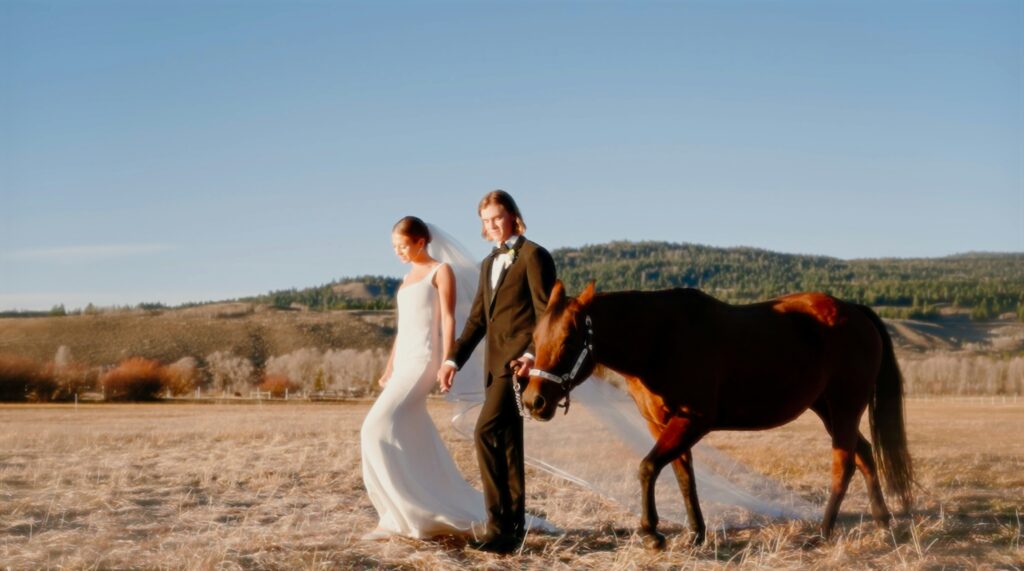
While golden hour provides inherently beautiful light, it takes real skill and experience to translate that into magazine-worthy images. Your photographer’s expertise becomes crucial during this limited window.
A talented photographer understands how to position you relative to the sun to create different effects—backlighting for romantic silhouettes, side lighting for dimensional portraits, or front lighting for classic looks. They’ll work quickly and efficiently to maximize the limited time while keeping you relaxed and natural throughout the session.
They’ll also anticipate how the light changes minute by minute as the sun sets. What looks perfect at 7:30 PM might require adjustment by 7:45 PM. An experienced photographer stays ahead of these changes, adjusting camera settings and positions to maintain consistent quality throughout your session rather than simply reacting to shifting conditions.
Conclusion
Understanding what time is golden hour for weddings empowers you to plan strategically and capture truly stunning images on your special day. While the exact timing depends on your wedding date, specific location, and seasonal variations, the planning principles remain consistent: calculate sunset time for your area, build in dedicated photography time during that window, choose locations with clear views, and communicate thoroughly with your photographer.
Golden hour photos aren’t just pretty pictures—they’re heirloom-quality images that capture the romance, emotion, and beauty of your wedding day in the most flattering light possible. These are the photos that will take pride of place on your walls, the ones you’ll show your children and grandchildren, and the images that will transport you back to that perfect moment for decades to come.
Ready to ensure your wedding day is captured in the most beautiful light possible?
At Celeste Wedding Photography, we specialize in creating timeless, romantic images that showcase your love story beautifully. We’ll work with you to plan the perfect wedding photography timeline that maximizes golden hour while ensuring you don’t miss a moment of your celebration.
Frequently Asked Questions About Golden Hour for Weddings
What happens if it’s cloudy during golden hour on my wedding day?
Cloudy skies create naturally diffused light that eliminates harsh shadows and provides even, flattering illumination. While you won’t get warm golden tones, you’ll still capture beautiful, soft images with a romantic feel. Your photographer can adjust their approach to create gorgeous photos regardless of weather conditions.
How long does golden hour actually last during a wedding?
Golden hour typically lasts 30-60 minutes, depending on your location, season, and atmospheric conditions. For wedding planning, budget at least 30-45 minutes for your portrait session. Your photographer will work efficiently to capture various poses and locations during this window.
Can we have golden hour photos if our ceremony is in the morning?
Yes! Morning golden hour occurs during the first hour after sunrise and offers the same warm, soft light as evening. You can incorporate sunrise portraits before or immediately after your morning ceremony. Just be prepared for an early start—potentially 6:00-7:00 AM depending on your location.
Do we need to tell our guests we’re leaving for golden hour photos?
Work with your coordinator to briefly announce you’re taking sunset photos so guests stay entertained. Time this break naturally between cocktail hour and reception introductions or before dinner service. Keep your session to 30-45 minutes maximum so you’re not absent too long.
What’s the best backup plan if we miss golden hour entirely?
Blue hour (just after sunset) creates dramatic images with deep blue skies as an excellent alternative. Nighttime photography with creative lighting also produces stunning, romantic portraits. You might also consider scheduling a next-day or engagement session during golden hour to capture those specific images.
